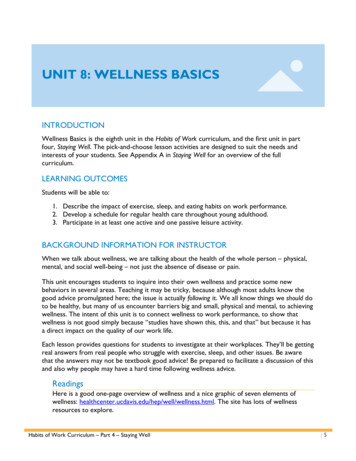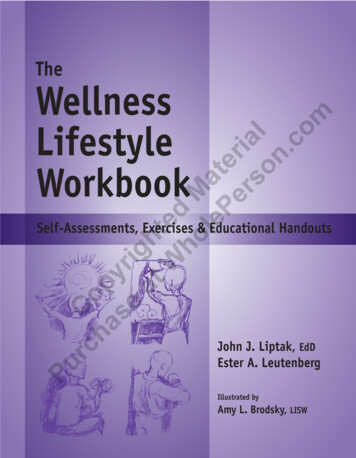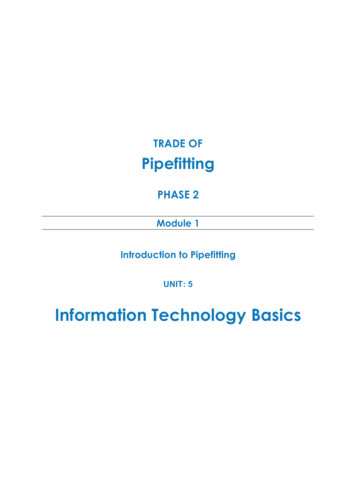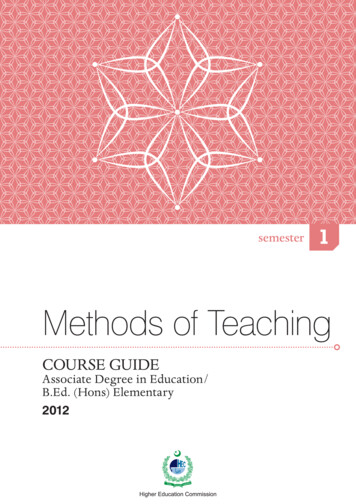
Transcription
UNIT 8: WELLNESS BASICSINTRODUCTIONWellness Basics is the eighth unit in the Habits of Work curriculum, and the first unit in partfour, Staying Well. The pick-and-choose lesson activities are designed to suit the needs andinterests of your students. See Appendix A in Staying Well for an overview of the fullcurriculum.LEARNING OUTCOMESStudents will be able to:1. Describe the impact of exercise, sleep, and eating habits on work performance.2. Develop a schedule for regular health care throughout young adulthood.3. Participate in at least one active and one passive leisure activity.BACKGROUND INFORMATION FOR INSTRUCTORWhen we talk about wellness, we are talking about the health of the whole person – physical,mental, and social well-being – not just the absence of disease or pain.This unit encourages students to inquire into their own wellness and practice some newbehaviors in several areas. Teaching it may be tricky, because although most adults know thegood advice promulgated here; the issue is actually following it. We all know things we should doto be healthy, but many of us encounter barriers big and small, physical and mental, to achievingwellness. The intent of this unit is to connect wellness to work performance, to show thatwellness is not good simply because “studies have shown this, this, and that” but because it hasa direct impact on the quality of our work life.Each lesson provides questions for students to investigate at their workplaces. They’ll be gettingreal answers from real people who struggle with exercise, sleep, and other issues. Be awarethat the answers may not be textbook good advice! Be prepared to facilitate a discussion of thisand also why people may have a hard time following wellness advice.ReadingsHere is a good one-page overview of wellness and a nice graphic of seven elements ofwellness: healthcenter.ucdavis.edu/hep/well/wellness.html. The site has lots of wellnessresources to explore.Habits of Work Curriculum – Part 4 – Staying Well 5
WELLNESS BASICS (UNIT 8)A simpler concept of wellness is the health triangle introduced by the World HealthOrganization in 1948. The three equal sides: physical, emotional and mental, emphasize theequal importance of each aspect: www.ehow.com/about 5047508 health-mental-socialphysical-definitons.htmlThe 10,000 Steps a Day program (pedometers): www.thewalkingsite.com/10000steps.htmlWhat happens when you skip a meal: ards-of-skipping-meals/This is a good definition of leisureactivities: en.wikipedia.org/wiki/Category:Leisure activitiesSleeping and napping tips: healthcenter.ucdavis.edu/hep/well/napping.html. Check out theNap Map, an annotated Google map with photos of great places to catch a 20-minute nap!Other ResourcesGeneral: New Hampshire Health Education CurriculumGuidelines: www.education.nh.gov/instruction/school health/curr guidelines.htm SuperBetter (also suggested in Unit 10: Stress Management) is a free online gamethat uses the structure of a game (e.g., superheroes, bad guys, quests, allies, points)to help you achieve a health-related goal you specify. Each time you log on you havetasks to complete. The designer was grappling with the question, “What if you tookall the energy people put into imaginary gaming worlds, and put it to use for realpurposes?,” when she got a severe concussion. She wrote the prototype of thisgame to help motivate herself to do the things that would help her get better. Thereis a text introduction, a graphical introduction, and a video introductionat www.superbetter.com. It’s fun!Exercise: Northeast Passage (NEP) is a program of the University of New Hampshire’sCollege of Health and Human Services. NEP delivers disability-related healthpromotion and adapted sports programs throughout New England. The website(www.nepassage.org/index.html) includes a long list of resources for almost anysport or activity you can think of. Let’s Move! is an initiative launched by Michelle Obama to solve the problem ofobesity. The website, www.letsmove.gov, has resources and action ideas for kids,schools, families, and professionals.Eating habits: ChooseMyPlate.gov – www.choosemyplate.gov – is the updated governmentnutrition site with information, strategies, and tools to calculate individual goals andHabits of Work Curriculum – Part 4 – Staying Well 6
WELLNESS BASICS (UNIT 8)ranges for healthy weight and activity levels. The website breaks down different agegroups over the life span. It also includes ideas for healthy eating on a budget, samplemenus, a tracker, and a tip of the day. Nutrition information for fruits andvegetables: tsRetailEstablishments/ucm063482.htm A great site to see nutritional information for all sorts of foodsis nutritiondata.self.com. Enter the food name at the top right of the web page. Forexample, this link takes you directly to the web page for acorndog: 44/2Health care: The Adolescent Health Transition Project is designed to help smooth the transitionfrom pediatric to adult health care for students with special health care needs.Information and materials can be found at depts.washington.edu/healthtr/. Envisioning My Future: A Young Person’s Guide to Health Care Transition –hctransitions.ichp.ufl.edu/products booklets.php – was written for Florida youthwith special health needs and their families, but most of the content appliesnationwide. There are separate sections for three different age ranges (12–14, 15–17and 18 plus). Each section includes information to help youth be more in charge oftheir own health care, tips for parents, and a checklist of transition skills andactivities. The guide is 24 pages, is available in English and Spanish, and can bedownloaded as a PDF. A summary of the HIPAA Privacyrule: www.caringinfo.org/files/public/ad/HIPPA Privacy Rule.pdfUNIT PREPARATION CONSIDERATIONSTasksThere are several activities that involve interviewing people at the workplace. As thequestions in this unit are personal, talk with the internship supervisor about the intent ofthe lesson and ask the supervisor to point the student to good people to interview.Look over local newspapers and community publications to expand your knowledge oflocally available leisure activities.If you do the: SuperBetter activity in the Exercise lesson: Play it yourself first. It’s pretty intuitive,but you’ll want to play enough that you can demonstrate the basic idea.Habits of Work Curriculum – Part 4 – Staying Well 7
WELLNESS BASICS (UNIT 8) Pedometer activity in the Wellness and Exercise lesson: You’ll need to locateenough pedometers for your class. Your school may have them available for studentuse; check with the nurse or health teachers. Students with iPods have a built-inpedometer application. Alternatively, a local sports store may give you a groupdiscount. Food label activity in the Eating Habits lesson: You’ll need to collect labels from avariety of healthy and unhealthy foods. Dunkin Donuts and McDonalds have all theirnutritional information on their websites, as may other chain restaurants. Field trip in the Health Care lesson: Contact Community Education or CommunityHealth at your local hospital or a local dentist. They may be able to makearrangements with appropriate medical personnel.SpeakersThis unit has several speaker suggestions. Scan the classroom introduction activities forideas. Contact these people early to arrange dates and times.Prior KnowledgeYou may need to preteach some of these concepts depending on the lessons and activitiesyou select: wellnesspreventative careHIPAA Privacy Rulehealth insuranceleisuretransferable skillsSUMMATIVE ASSESSMENT IDEASFollowing are ideas for a summative assessment for this unit:1. Create a brochure that explains your personal wellness plan (learning outcomes 1, 2, 3).Be realistic! Include the following: your daily exercise when you will go to bed on school nights breakfast and lunch plans your next health care visit (doctor, dentist, optometrist) one active and one passive leisure activity you’ll participate in regularly2. Pick one of the wellness factors that can affect work performance (exercise, sleep,proper health care, nutrition, leisure activities). Work in a group with other studentswho have chosen the same wellness factor. Create a piece of work (PowerPointpresentation, poster, skit, poem, true/false quiz, video) that explains the impact of theHabits of Work Curriculum – Part 4 – Staying Well 8
WELLNESS BASICS (UNIT 8)wellness factor on your work and suggests tips for making it part of a healthy lifestyle.Present your piece of work to the class (learning outcome 1).UNIT KICKOFFThree options:1. Use this word splash to spark a discussion ofwellness: y you could use Wordle, www.wordle.net/, to determine new, highfrequency vocabulary you may need to preteach. Cut and paste a section of text contentfrom a health and wellness website into the Create page. Have students review andidentify unfamiliar words in the word cloud, using the criteria, “I cannot explain thisword meaning to someone else,” as the deciding factor for needing to review or reteachor preteach.2.Watch this 2:07-minute video, “Funny Group Health Find More MinutesCommercials,” a series of three humorous commercials about different aspects ofwellness and work: www.youtube.com/watch?v 0syQFLfMbCo. Use it to spark adiscussion of wellness and how it affects the world of work.3.Have students rate their stress level (1–5), then list how much sleep they got lastnight, what they’ve eaten in the past 12 hours, and how much exercise they’ve done inthe past 24 hours. Now watch the 2:47-minute video, “Look After Your Brain –BrainSmart – BBC” at www.youtube.com/watch?v 12pbrkcfRDI&feature related, whichlinks brain performance and wellness practices. Have students compare theirinformation to see if more sleep and exercise and better diet lead to decreased stressfor the class as a whole.LESSONSThis unit is divided into the following lessons. The lessons contain choices for activities and areorganized into an instructional sequence around a workplace assignment.1.2.3.4.5.ExerciseSleepEating habitsHealth careLeisure activitiesHabits of Work Curriculum – Part 4 – Staying Well 9
WELLNESS BASICS (UNIT 8)LessonsInstructionalSequence1. ExerciseIntroduction – individualActivitiesJournal. Keep a log for a week and writedown every activity you would count asexercise. Do you think it is enough? Are you ingood shape?Journal. Keep track of things you could doto increase your activity level as you gothrough your day (e.g., take the stairs insteadof the elevator, park at the end of the parkinglot so you walk further to get to yourdestination, run on a treadmill or do stretchingexercises while watching television). Star twoor three of these things to try during theindividual follow-up activity at the end of thislesson.Introduction – classroom.Wellness statements. Create a set of wellnessstatements and ask students to code thestatements as follows:1 – means I do that now2 – means I could make a commitment todo that easily3 – means it is out of my reach or I’m notinterestedStudents then discuss how they coded theirwellness statements and select one statementthat they would like to make a priority.Fishbowl panel. Invite a school nurse,health teacher, yoga teacher, dietician, athletictrainer, physical education teacher, humanresources person, and guidance counselor toparticipate in a panel discussion about wellness.Students prepare questions ahead of time andthe panel discusses the answers with studentsas the audience. Include the topic of sleep.Workplace activityHabits of Work Curriculum – Part 4 – Staying WellAsk the HR person at your workplace ifyour company offers wellness activities, localgym discounts, insurance reimbursements, orfitness classes. Are there any walking trails?Workshops? A fitness person on staff? 10
WELLNESS BASICS (UNIT tivitiesWhat do people at your workplace doduring the day for personal fitness? Whatmotivates them to do it? What do they doafter work for fitness?Follow-up – individualMental notes. Go for a brisk 10-minute walkbefore your internship. Make mental notes onanything you notice about your energy andfocus afterward.Evening exercise. Chart what you do in theevenings for one week. Now make a list of allthe different silly but workable ways you canadd in exercise in five to 15-minute chunksthroughout your evening before you go to bed.Commit to doing one each night.Journal and activity. Use a pedometer andstrive to get to 10,000 steps per day. Howmany days did it take you? Any surprises? Learnanything new?Journal and SuperBetter. Play the onlinegame, SuperBetter, at www.superbetter.com.Pick an exercise that is important to you andplay SuperBetter for two weeks. At the end oftwo weeks, write a progress report in yourjournal.Follow-up – classroomGroup exercise plans. Create lists of silly butworkable ideas (that work) for adding five to15-minute chunks of exercise throughout yourevening. Make individual charts showing athree-week personal plan for daily exercise.Have a weekly group check-in. Share tips forkeeping on track. Share anything you noticethat changes about your school or workperformance.Pedometers. Take on a class challenge ofwalking 10,000 steps per day per person. Trackyour progress on a wall graph.Class discussion. Share what you learned in theworkplace about adults and their exercisehabits. What do they see as the benefits? DoHabits of Work Curriculum – Part 4 – Staying Well 11
WELLNESS BASICS (UNIT tivitiesyou notice anything similar when you exercise?Local resources. Brainstorm a class list of lowcost or no-cost community or neighborhoodresources for wellness and being active (e.g.,walking paths, mini golf, city bike trails). Expandyour list by reviewing local print resources andwebsites. Plan a field trip to try one of theresources.Personal workout plans. Invite a physicaleducation teacher or other exercise resourceto set up a personal plan with each student.Use class time for students to do a part oftheir plan each day.2. SleepIntroduction – individualWatch this 0:58-minute video, “Whatare the side effects of poorsleep?,” www.youtube.com/watch?v L5L82ARlSk. Make a list of the side effects. For eachone you have experienced, write twosentences describing what happened.Watch this 1:55-minute video, “HowMuch Sleep Do I Need?,”at www.youtube.com/watch?v tuNp M0Vg4Q.Write a journal entry describing how muchsleep you typically get during the week. Howdo you spend the last 30 minutes before goingto sleep? How about on the weekend? When isyour preferred bedtime and wake-up time?Introduction – classroomNotice the difference. Complete the followingsentence eight times: When I am tired I noticethat Then complete the following sentenceeight times: When I am rested I notice that Compare results with the rest of the class.Generate a class list of “When I am tired Inotice:” and “When I am rested I notice:.”Invite a local occupational therapist orphysical therapist to come speak about theimportance of exercise and sleep to overallwellness. Include tips on getting more andHabits of Work Curriculum – Part 4 – Staying Well 12
WELLNESS BASICS (UNIT 8)LessonsInstructionalSequenceSleep, continuedActivitiesbetter sleep (there’s a similar activity in thewellness and exercise lesson).Workplace activityAsk your supervisor about the impact ofinadequate sleep on employees and employers.How and when is it a problem?Ask three coworkers what they noticeabout their work performance when they’retired as compared to when they’re rested.Follow-up – individualJournal. Make a plan to improve your sleeppractices, if needed. Consider keeping a dreamjournal as part of your plan. Write a journalentry about what you will do. Try it for twoweeks and write another entry about how itwent.Chart. Make a chart to track your hours ofsleep for a few weeks. See if attention to sleepimproves it.Sign. Create a workplace sign that is a symbolonly – no words – that represents RestedEmployee Work Zone.Follow-up – classroom3. Eating habitsIntroduction – individualHabits of Work Curriculum – Part 4 – Staying WellClass nap. Watch this 2:49-minute video,“How to Power Nap,” about how to take aneffectivenap: www.youtube.com/watch?v gZ0oEedMX6s. Plan and take a class nap. The next day, sharewhat you noticed about your energy level andfocus the rest of the day. This could also be anintroduction activity.Stop action skits. Brainstorm barriers to goodsleep. Ask for volunteers to act out one of thebarriers. At an appropriate point, stop theaction. Ask another group to take over the skitand demonstrate a solution. Repeat for severalof the barriers.Journal. Read this short article, “TheClaim: Skipping Breakfast Can Affect YourMood and Energy Levels During the Day,”at www.nytimes.com/2006/02/21/health/21real. 13
WELLNESS BASICS (UNIT 8)LessonsInstructionalSequenceEating habits,continuedActivitieshtml, then watch this 3:17-minute video, “TheImportance of Breakfast”at www.youtube.com/watch?v 06PHE5IMBQo&feature related. Create a breakfast menuwith healthy and unhealthy items. Circle theitems you eat for a typical breakfast.Journal. Read “Fruits and Veggies on theGo,”at onthego.pdf and look over some of thethe charts, “Common Foods Comparison”,at www.sparkpeople.com/resource/food listsmeats.asp. Find images on the Internet of yourtypical snacks or cut out snack photos from oldmagazines. Add some images of healthy choicesyou could make a commitment to try.Introduction – classroomCompare sugar and protein content from avariety of food labels. Compare the sugar andcaffeine content of popular sodas (includeenergy drinks). List several options for healthysnacks or meals. Be sure they are options classmembers will actually eat!Invite a registered dietician from your localhospital or a home economics teacher to speakabout practical ways to put together a healthybreakfast and healthy snacks, as well as theeffect of high sugar and high caffeine drinks onyour body.Check out the vending machines at yourschool. Discuss what is healthy to eat fromthem and what may not be so good.Food log. Each student logs everything he orshe eats for a few days. Then, in small groupsor pairs, evaluate your eating habits with apeer. Pick one thing to try and improve.Workplace activityHabits of Work Curriculum – Part 4 – Staying WellSnack experiment. One day, have a healthysnack or meal before work and make mentalnotes about your energy level and mood. Onanother day, have an unhealthy snack or mealand make more mental notes about your 14
WELLNESS BASICS (UNIT 8)LessonsInstructionalSequenceEating habits,continuedActivitiesenergy level and mood.Bag lunch. Pack a healthy lunch or snack forwork. Put a note in your lunchbox that inspiresyou and reminds you of the importance ofeating healthy foods.Mental notes. Notice what food is available atwork. Is it healthy or not?Follow-up – individualTake a favorite recipe for a not-so-healthy fooditem and try to make it healthier (e.g., usewhole wheat pasta, use low-fat cream cheese,substitute applesauce for sugar), or find ahealthy recipe for your favorite food on theInternet. If possible, make the healthy item andsee how it compares to your original recipe.Journal and activity. Identify two ways youcould improve your breakfast, write them inyour journal and try them for a week. Writeanother journal entry describing what you triedand any differences you noticed in your mood,memory, and energy level.Earn a class feast. Each morning for a weekmake a list of one healthy food item you addedto your breakfast to replace an unhealthychoice. Or if the food is not available – ahealthy alternative you wish you could eat forbreakfast. Give yourself a star for each morningyou made a healthy food swap. Bring this toclass. Five stars from each student in the classearns a healthy snack feast for all!Follow-up – classroomBag lunch surprise. Each student packs a baglunch (no names on bags). Put all the bags on atable and each student chooses one. Shareyour good ideas with each other and giveawards for the best items.Share the results of your snack experiments.What was similar in your experiences? Whatwas different? What conclusions can you draw?Field trip. Many grocery stores have created inhouse nutritional rating systems. For example,Hannaford has GuidingHabits of Work Curriculum – Part 4 – Staying Well 15
WELLNESS BASICS (UNIT 8)LessonsInstructionalSequenceEating habits,continuedActivitiesStars: www.hannaford.com/content.jsp?pageName GuidingStars&leftNavArea HealthLeftNav.Price Chopper has the Nuvalsystem: www2.pricechopper.com/nuval/. Makea class list of favorite foods. Take a field trip toa local grocery store and compare thenutritional value of different foods and brands.If you can’t do a field trip, consider an in-classactivity using the websites of the above stores.Food price analysis. Sometimes eating in ahealthy way is difficult because of cost. Use theabove websites to analyze price differencesbetween different kinds of foods. What could aperson on a limited budget do to findaffordable healthy choices? Share your findingsand ideas.4. Health careIntroduction – individualJournal. Read the article that matches yourgender:“Health Screening – Women – 18 to 39,”at m, or“Health Screening – Men – 18 to 39,”at m.Make two health screening lists: one of theitems you feel confident taking care of andanother list of the items you need to learnmore about.Journal and activity. Look at the pictures ofhealthy and diseased teeth and gums at thesetwowebsites: tment/and www.winghavenortho.com/cavities.php.Inspect your own teeth and gums closely.Write a journal entry describing what you see;use lots of adjectives. Now floss your teeth.Do you get any bleeding? Make a chart for dailybrushing and flossing for one month. Post it inyour bathroom and fill it out every day.Habits of Work Curriculum – Part 4 – Staying Well 16
WELLNESS BASICS (UNIT 8)LessonsInstructionalSequenceHealth care,continuedActivitiesJournal. Create a chart with four columns:medications, rules, when to take, notes.Complete the chart for your medications. Thenotes column will be blank for now – you’ll fillit in later.Introduction – classroomField trip. Make a class appointment at a localhospital, medical center, chiropractor,naturopath, or dentist. Class goes through theadult process of getting to a medicalappointment on time, registering, and seeingthe medical practitioner. Class interviews thedoctor/nurse about what is the recommendedhealth care for young adults up to age 30.Find out about classes, activities and lectureseries on health and fitness topics. Collectbrochures and handouts to create a referenceor information binder. You may want to usethe field trip as an opportunity to talk aboutthe HIPAA Privacy Rule aswell, www.caringinfo.org/files/public/ad/HIPPAPrivacy Rule.pdf.Invite a community health educator tospeak to the class about the recommendedhealth care for young adults up to age 30 (e.g.,finding a doctor, regular physicals withsomeone who knows you, suggested tests).Include what community services offer lowcost health screenings (e.g., flu shots, bloodpressure checks). Include traditional andalternative medicine options.Workplace activityFind out what health insurance is offered, ifany. What are the options? What is the cost toan employee? What would a doctor’s visitcost? If possible, bring back a benefits summaryto share with your class. Bring back otherprinted information to add to your informationbinder.Ask HR if there are any guidelines for whenor where to take medications at work.Habits of Work Curriculum – Part 4 – Staying Well 17
WELLNESS BASICS (UNIT 8)LessonsInstructionalSequenceHealth care,continuedActivitiesAsk HR about the policies around illness.What do employees do if they are sick? Howdo they decide if they should come into workor stay home? Do they get paid sick time?Bring back a copy of the policy if you can.Ask HR if your workplace does onsitephysicals. Some employers do them at the timeof hire. Some require them but do not pay forthem. Do you need to repeat your physicalperiodically? Do you need any tests (like TB)?Who pays for them? Is there other health careavailable at the workplace? If possible collectany print material for your information binder.Follow-up – individualMedical file. Create a medical file for yourselfwith your vaccination record, list ofmedications, list of allergies, dates of lastdoctor visits, contact information for yourmedical professionals, copy of your healthinsurance card, emergency contact person andnumber, and any other details that would begood to know. If appropriate, include a list ofyour medications, when to take them, andpotential food or drug interactions.Journal. Complete the notes column ofyour medication chart with anything you needto remember about taking medications at work(e.g., the work rules you need to follow).Journal. Check your health screening listsfrom the Introduction activity. Have youlearned how to address any more on the list?Make an action plan to learn how to do onemore item. Set a goal with a timeline.Follow-up – classroomHabits of Work Curriculum – Part 4 – Staying WellComparison dyads. Work in pairs to comparehealth insurance from the different workplaces.What would a year of your recommendedhealth care cost on the different plans? Arethere any paid incentives to completescreenings or engage in physical activity? Makea class chart of similarities and differences. 18
WELLNESS BASICS (UNIT 8)LessonsInstructionalSequenceHealth care,continuedActivitiesDesign a medical information form thatstudents can fill in and take with them to theirworkplaces. The form lists medical informationthat might be needed in case of an emergency(e.g., primary care doctor, preferred ambulanceservice and hospital). You may want to justmodify the form that parents usually sign andcomplete for field trips.Research summary. Compare and contraststudent internship site policies about employeeillness. Speculate about the reasons for thedifferences.5. LeisureactivitiesIntroduction – individualJournal and activity. Read the short onlinearticle, “Spare Time,”at ml. Write a journal entry describingyour active and passive leisure activities. Whichones are your favorites? What do you like bestabout your favorites? List three transferableskills you’ve learned from your activities.-orCreate an invitation to a weekend of leisure.In your invitation include your active andpassive leisure activities. Also include the threetransferable skills your guests will take awaywith them.Watch this 4:50-minute video, “LeisureTime Activities,”at www.youtube.com/watch?v EqGdIxP-W5Y.Part of it is excerpted from a 1950 film. Writea journal entry about your reaction to thevideo. What is still true for teens today? Whathas changed? Do you see any gender bias in thefilm? How do you spend your free time?Introduction – classroomHabits of Work Curriculum – Part 4 – Staying WellThis might be an opportunity to create anduse a Google Docs survey. Poll the class fortheir interests and areas of curiosity aboutleisure activities (e.g., golf, hiking, birdwatching). Which locally available activities 19
WELLNESS BASICS (UNIT 8)LessonsInstructionalSequenceLeisure activities,continuedActivitieswould they like to know more about? Bring inlocal experts to give talks and lead activities.Charades. Act out what you like to do whenyou have free time. Make a class list of theacted-out leisure activities and then divide thelist into active and passive activities. When isactive leisure a better choice? When is passiveleisure a better choice? Now take it farther byidentifying work skills people could learn fromthese activities.Workplace activityAsk three coworkers what they like to doin their leisure time? What do they do torecharge at work?Ask your supervisor about any leisureactivities that are sponsored or encouraged bythe workplace. Does the workplace pick uptrash along a section of highway, sponsor abowling or softball team, allow employees totake a day off to spend on a community serviceactivity?Follow-up – individualJournal and activity. Pick one new activeand one new passive leisure activity to try. Usea local resource to try them both, then write ajournal entry describing what you liked anddidn’t like about each activity. Will you trythem again?Friends and family. Interview a friend or familymember about their leisure activities(preferably someone who doesn’t share yourown leisure activities). Ask them to describethese activities, say what they enjoy aboutthem, and describe how they decide whichleisure activity to pursue when.Follow-up – classroomHabits of Work Curriculum – Part 4 – Staying WellPaper bag skits. Fill grocery bags with 10random objects. Challenge teams to come upwith as many leisure activities as they can in 10minutes, connecting each one to at least oneobject. Share the results with the class. At theend, ask each student to share one passive and 20
WELLNESS BASICS (UNIT 8)LessonsInstructionalSequenceLeisure activities,continuedActivitiesone active activity that truly interests them,regardless of whether the student currentlyparticipates in the activity.Class tallies. Create a class list of all leisureactivities, both active and passive, in whichstudents participate. Place tally marks next toeach activity to represent t
Habits of Work Curriculum – Part 4 – Staying Well 5 UNIT 8: WELLNESS BASICS . INTRODUCTION . Wellness Basics is the eighth unit in the Habits of Work curriculum, and the first unit in part four, Staying Wel










